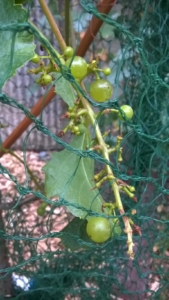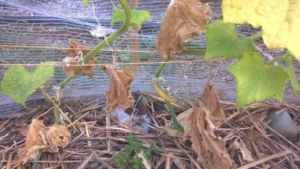Stop and Stare
August 29, 2023
To stop and stare at the plants and trees in the orchard is not only a connection with nature, it is a pathway for better plant care. In recent years, I walked briskly past the plants, like a race horse with blinders on, to focus on some maintenance task. Now retired, I have more time to stop and stare and take note if any plants are hanging out with bad company!
Let’s discuss the case of the missing Interlaken grapes, when stop and stare was lacking. The vine was flush with grape clusters in early August so we covered the vine with bird netting. Netting deters squirrels, birds and rats from destroying more than their fair share of the sweet fruit. This past week, when we tasted the grapes for ripeness, we found them ripe, but most of them were gone.
For the past couple of weeks no one had bothered to stop and stare, so we don’t know who the villain is. We can only guess. We moved closer to the vine for clues and ruled out human indecency. Our best guess is to point our finger at the rats since many grape clusters were touching the net and because there were grape stems in the bottom of the net. Had we made more frequent stop and stare observations, we would know how to tweak our grape protection system for next season.
Now ponder the case of the dying cucumber plants. Even if you had sprinted through the orchard, you  would have smelled death near the cucumber bed. The plants were dying, exactly in the manner of the Wicked Witch – shrinking, withering and melting to the ground. Stop and stare we did, many times! We dug around the base of the plant to look at the root collar and we tested for a bacterial disease. We reviewed a soil sample and a leaf infusion under the microscope.
would have smelled death near the cucumber bed. The plants were dying, exactly in the manner of the Wicked Witch – shrinking, withering and melting to the ground. Stop and stare we did, many times! We dug around the base of the plant to look at the root collar and we tested for a bacterial disease. We reviewed a soil sample and a leaf infusion under the microscope.
We are still investigating, as cukes are an important vegetable for the food bank. We are confident that our stop and stare sessions will help us prevent the problem next year.
Sat. Oct 21, 2-4, Annual Cider Fest
Please email to volunteer – freewayestatescommunityorchard@gmail
Keen observation allows you to listen to the moans and complaints of your plantings and then experiment with better methods to care for them. Last year I failed to notice San Jose scale (Quadraspidiotus perniciosus) on the William’s Pride apple tree, partly because there were very few  apples.
apples.
 This year the apples were abundant and sweet, but small. A stop and stare moment revealed that many had tiny white spots surrounded by purple halos. Within that small blemish, underneath a layer of amour, rests a tiny scale insect that sucks nutrients, not only from apples but, more importantly, from the the branches and leaves. The tree is really suffering but we have a plan for the spring. There is not much we can do at this point in the season but at least we banded the tree to stop the migrating ants from attacking and feeding on the parasites and predators of scale.
This year the apples were abundant and sweet, but small. A stop and stare moment revealed that many had tiny white spots surrounded by purple halos. Within that small blemish, underneath a layer of amour, rests a tiny scale insect that sucks nutrients, not only from apples but, more importantly, from the the branches and leaves. The tree is really suffering but we have a plan for the spring. There is not much we can do at this point in the season but at least we banded the tree to stop the migrating ants from attacking and feeding on the parasites and predators of scale.
The stop and stare routine, as you already guessed, can be generalized. The slower I move, the more I notice. The more I notice, the more I learn. The more I learn, the more I care.
Ruth

Thanks, Ruth,